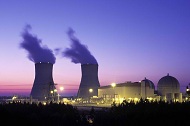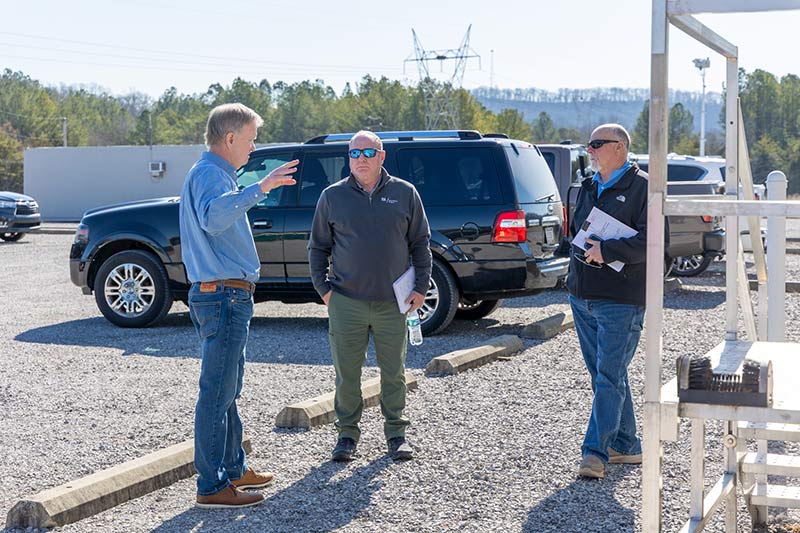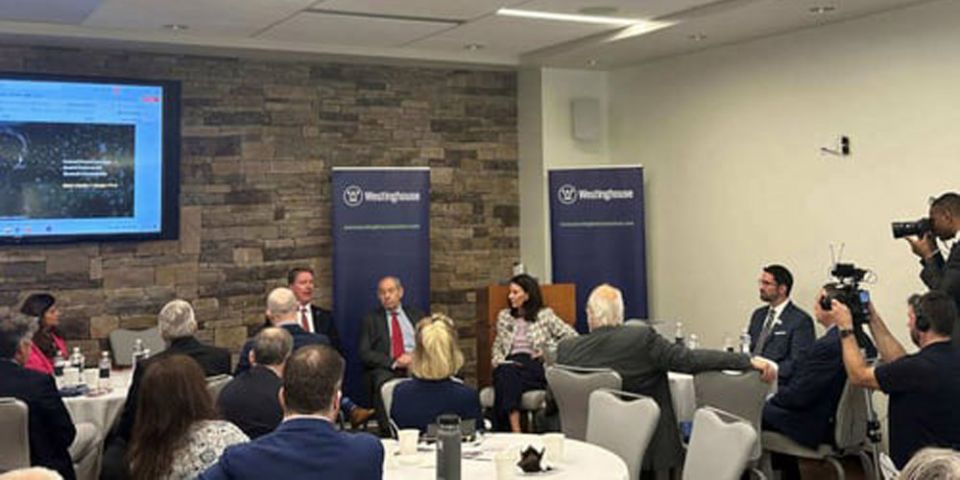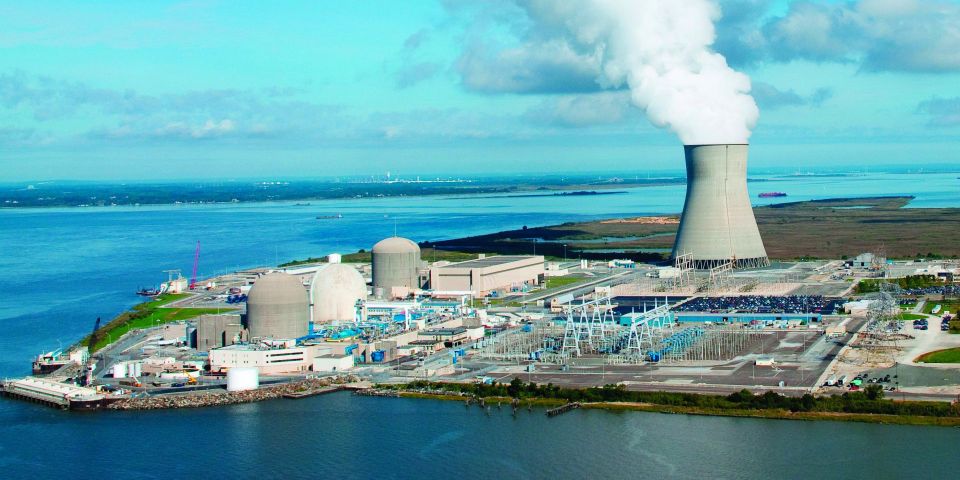How Can Nuclear Construction Costs Be Reduced?
 This month's post discusses my ideas on an issue I've been thinking about for awhile. Although we have four new reactors under construction in the United States (at Vogtle and Summer), the nuclear "renaissance" has so far not been nearly as strong as many had hoped. This begs the question as to what is holding nuclear back.
This month's post discusses my ideas on an issue I've been thinking about for awhile. Although we have four new reactors under construction in the United States (at Vogtle and Summer), the nuclear "renaissance" has so far not been nearly as strong as many had hoped. This begs the question as to what is holding nuclear back.
Impediments to nuclear growth
Some have suggested the need for even safer reactors, despite the fact that overall nuclear is already among the safest, if not the safest of all energy sources. The fact that any direct health consequences of Fukushima, which was essentially a worst-case nuclear accident, have been essentially non-existent further suggests that insufficient safety is not the primary area needing improvement (or factor limiting nuclear's growth).
 Others believe that the nuclear waste issue is the main reason holding nuclear back, and that "solving" it (by closing the fuel cycle and through other advances in fuel cycle technology) would "unleash" nuclear to grow and solve our energy problems. The truth, however, is that indefinite on-site storage of all of a plant's waste (in the pool and in dry casks), versus having the Department of Energy take it away after a few decades, increases the cost of nuclear power by only ~0.1 cents/kW-hr. Waste management activities will never be a significant fraction of nuclear power's total cost, regardless of what waste policy is adopted, or what fuel cycle we develop. I had thought that the perceived lack of a waste solution would significantly reduce support for nuclear, but it appears that, at least where almost all new US nuclear projects are proposed (in the Southeast), there is an ample degree of public/political support for new reactors.
Others believe that the nuclear waste issue is the main reason holding nuclear back, and that "solving" it (by closing the fuel cycle and through other advances in fuel cycle technology) would "unleash" nuclear to grow and solve our energy problems. The truth, however, is that indefinite on-site storage of all of a plant's waste (in the pool and in dry casks), versus having the Department of Energy take it away after a few decades, increases the cost of nuclear power by only ~0.1 cents/kW-hr. Waste management activities will never be a significant fraction of nuclear power's total cost, regardless of what waste policy is adopted, or what fuel cycle we develop. I had thought that the perceived lack of a waste solution would significantly reduce support for nuclear, but it appears that, at least where almost all new US nuclear projects are proposed (in the Southeast), there is an ample degree of public/political support for new reactors.
No, it's pretty clear that the primary factor holding nuclear back is economics, particularly the high upfront capital cost of new reactors. The current low price of natural gas, coupled with a weak economy (and associated lack of power demand growth), and the lack of taxes or limits on CO2 emissions does not help, but it is also true that the costs of reactor construction have increased substantially over the past ~8 years (and increases in labor or raw materials costs do not come close to explaining this). In addition to escalating initial cost estimates, many if not most current reactor projects have been experiencing fabrication issues and cost overruns.
How can we reduce costs?
Based on the above, it seems clear that nuclear research and development should focus primarily on ways to reduce nuclear plant construction costs, and less on fuel cycle or even safer reactor technology. Even the safest conceivable reactors and fuel cycle will do nothing to help overall public health and safety and reduce environmental impacts if nuclear is not deployed - due to high capital cost - while fossil fuels (which are vastly worse than current reactor technology in terms of public health and safety) are used instead. Ideally, this is something the Nuclear Regulatory Commission would keep in mind as well.
 What is really needed, however, is to have all the experts sit down and perform a thorough, objective evaluation to figure out what is driving nuclear construction costs, and what needs to change to reduce those costs. In this analysis, everything needs to be on the table-all regulations, policies, and practices. Nothing can be viewed as sacred or unchangeable (i.e., "that's just the way things are in the nuclear business"). We need to fundamentally reexamine all of our current policies and requirements, to determine which ones produce the most bang for the buck in terms of public health and safety benefit.
What is really needed, however, is to have all the experts sit down and perform a thorough, objective evaluation to figure out what is driving nuclear construction costs, and what needs to change to reduce those costs. In this analysis, everything needs to be on the table-all regulations, policies, and practices. Nothing can be viewed as sacred or unchangeable (i.e., "that's just the way things are in the nuclear business"). We need to fundamentally reexamine all of our current policies and requirements, to determine which ones produce the most bang for the buck in terms of public health and safety benefit.
Not only should nuclear requirements be compared to each other (for benefit vs. cost), but nuclear requirements should be objectively compared to the requirements placed on other energy sources and industries. One mindset that simply must disappear is that of "nuclear exceptionalism", which views nuclear's potential impacts/accidents to be uniquely unacceptable (i.e., that radio-isotope pollution is a uniquely unacceptable form of pollution), and that therefore, unlike other industries, no expense should be spared to remove even the tiniest chance of release. By extension, we should ask why non-nuclear power plants are so much cheaper to build. Is it that nuclear plants are more complex, or have more safety features, or is it the unique quality assurance requirements that only apply to nuclear?
My personal view is that the main factor leading to high plant construction costs is not the design of the reactors, or various safety features that they employ, but the uniquely strict QA requirements that apply (only) for the fabrication of safety-related nuclear plant components (i.e., "nuclear grade" components). Conversely, I believe that in terms of safety, fundamental reactor design, employed safety features, intelligent operation/training, and maintenance are much more significant (effective) than the application of extremely stringent fabrication quality control requirements. This is a personal opinion that I welcome comments on-the purpose of this article being to start a discussion.
The costs of nuclear's unique QA requirements
Having supplier qualifications and requirements for component fabrication that far exceed those applied to any other industry can lead to dramatically higher costs, for multiple reasons. In addition to the increased costs of compliance, the number of qualified suppliers is much smaller, which in turn results in supply bottlenecks, not enough fabrication capacity to meet demand, and (essentially) a bidding war for components. This seems to be a far more plausible explanation for the observed increase in reactor construction cost (vs. that initially estimated) than any shortages of labor or raw material. Conversely, if the nuclear industry could use a more typical set of industrial quality requirements (e.g., ISO-9000), the number of suppliers would increase dramatically, there would be ample supply and significant competition, and costs for nuclear components could drop substantially.
 It seems clear that problems complying with fabrication QA requirements, as opposed to reactor design features, are primarily responsible for reactor project cost overruns, since the reactor design was fully understood at the time of the initial cost estimate. Also, meeting "nuclear grade" fabrication requirements is the reason most often cited in the numerous articles discussing cost overruns at nuclear projects.
It seems clear that problems complying with fabrication QA requirements, as opposed to reactor design features, are primarily responsible for reactor project cost overruns, since the reactor design was fully understood at the time of the initial cost estimate. Also, meeting "nuclear grade" fabrication requirements is the reason most often cited in the numerous articles discussing cost overruns at nuclear projects.
At Vogtle, they are having significant problems, and cost overruns, due to the construction of something as simple as the concrete pad that the reactor will sit on. This comment from an article on the Vogtle difficulties is typical: The fabricator was "not accustomed to the requirements to document every step in the fabrication process. Correcting the mistakes took eight months for one of its modules...." In addition to problems such as this, the Vogtle project is literally spending billions of dollars on quality control programs.
Similar problems are occurring for the nuclear projects in Finland and France, QA/fabrication issues being the primary reason for cost overruns. And yet, those same reactor designs, with all the same safety features, are being built at a fraction of the cost in China. Why the difference? I believe that lower labor costs are only part of it.
I've also, anecdotally, heard many stories about how the nuclear-grade version of a component often costs several times that of the commercial/industrial-grade version of the same thing. This is not due to any material difference in the component; just the QA paperwork cost and the (severe) lack of nuclear-qualified suppliers. I have significant doubts as to whether the safety benefits are worth the additional cost.
Potential negative impacts on safety?
Due to onerous QA requirements, as well as the nuclear industry practice of taking a great deal of time in analyzing everything ("analysis paralysis"), there can be significant reluctance to make changes, including adding safety features or improvements. In addition to making it more difficult to change, or even fix things, these practices also act to stifle innovation and technological progress in our industry. The NRC "review barrier" to new, innovative, safer reactor designs is but one example.
Consider the following example: the NRC is debating whether or not to require filters on reactor vents that would remove most of the cesium from any vented air stream that may be necessary to control containment interior pressure in the case of a severe accident. (Failure to vent was a major factor in the Fukushima event, resulting in a much larger release.) In my opinion, such a design feature seems to be extremely worthwhile, since it greatly reduces potential cesium releases, and the long-term consequences of severe nuclear accidents pretty much scale (specifically) with the amount of cesium released. The filters would cost ~$16 million per reactor.
Meanwhile, the Vogtle project was significantly delayed (several months) due to minor, inconsequential variations (from the specified design) in the rebar within the concrete pad that the reactor will sit on. Eventually, the NRC agreed that the alternate configuration was fine, but it took an inordinate amount of time (and money) to reach that conclusion. Under current practices and procedures, addressing any changes or deviations from an approved design is extremely difficult and time-consuming. Did this base pad rebar issue cost the Vogtle project more than $16 million? I'm pretty sure it's much more than that.
 So the question is, which is better bang for the buck in terms of safety: installing cesium filters on containment vents for $16 million, or spending a much larger sum to address (or correct) a small/inconsequential change to the rebar configuration in the plant foundation? To me the answer is obvious. Would dramatically reducing the cesium release in the event of a severe accident result in a significant reduction in nuclear's overall risk? Absolutely! A small change in the configuration of the rebar in the (passive) concrete pad that the reactor sits on? I cannot, for the life of me, imagine how that would have any significant impact on the likelihood or severity of a significant accident/release.
So the question is, which is better bang for the buck in terms of safety: installing cesium filters on containment vents for $16 million, or spending a much larger sum to address (or correct) a small/inconsequential change to the rebar configuration in the plant foundation? To me the answer is obvious. Would dramatically reducing the cesium release in the event of a severe accident result in a significant reduction in nuclear's overall risk? Absolutely! A small change in the configuration of the rebar in the (passive) concrete pad that the reactor sits on? I cannot, for the life of me, imagine how that would have any significant impact on the likelihood or severity of a significant accident/release.
Despite this, whereas the cesium filters may end up not being required, the fact that Vogtle had to do what it did to resolve a minor deviation from licensed design (any deviation from licensed design), is not even questioned. It's just "the way things are in our industry".
There have been some allegations made that the nuclear industry is not doing enough in terms of flood protection or component maintenance at some sites. Improvements in these areas may very well result in measurable reductions in risk, but, in my opinion, excessive (and unique to nuclear) QA requirements make any such responses or improvements so difficult and expensive that the industry is sometimes reluctant to implement them. That's both in terms of component fabrication QA requirements and the amount of analysis and review that is required for any actions or changes. The end result could actually be a net increase in overall risk.
In my view, risks from component fabrication defects are not a significant fraction of overall nuclear risk. No serious accident has ever resulted from a fabrication defect. Instead, the rare instances that have occurred resulted from poor reactor design, operator error, or from things the industry just hadn't thought of. Fukushima is probably an excellent example of the latter. They simply didn't anticipate (or view as credible) a tsunami of that height. Seawall fabrication defects were not the issue.
In other words, let's put cesium filters on reactor vents, but pay, say, ~$4 million for them, instead of $16 million, by foregoing the impeccable fabrication and paperwork requirements required for "nuclear grade", "safety related" components. Let's apply the QA requirements/standards that generally apply for other industries, or perhaps even use "commercial grade" filters. It would surely be better than doing nothing.
Lazy thinking?
I've been in the industry long enough to know how most will respond to the above (rash) proposal. Industry thinking tends to be that if full, nuclear-grade QA requirements are not applied to a component, it's the same as it simply not being there. Probability of function is 0%, regardless of the fact that such a failure type (or mode) is completely impossible.
Given the huge costs of nuclear-grade QA requirements, the industry has not put nearly enough time and effort into evaluating the probability of failure of non-nuclear grade/qualified components, and what the nature of any failures would be. Such evaluations should be followed by detailed probabalistic risk assessment (PRA) analyses to determine what the effect on accident/release frequency (and severity) would be of having various components not be nuclear-grade. These effects, on risk, should then be objectively compared to other options for reducing risk, such as fundamentally safer reactor designs, or the employment of various safety features (e.g., vent filters).
Such an effort has not been made, however (the NRC's new "risk-informed" philosophy is a far cry from what I'm talking about). It's easy to follow up any analysis or evaluation with the statement: "and it shall be a perfectly constructed component, with zero defects", without any regard for how much it will cost to make such a guarantee. That way, one doesn't need to do the hard task of evaluating the likelihood and consequences of (realistic) component failure. Also easy is the notion that zero changes or deviations from the approved design are allowed, and that any change at all (no matter how small) requires re-performing and re-reviewing all the associated licensing analyses/evaluations. How about exercising a little engineering judgment?
 One has to ask how other industries handle fabrication defects or deviations. It seems clear it's not the way the nuclear industry does, given their lower construction costs, shorter schedules, and fewer cost overruns. It's not like construction projects such as bridges, tall buildings, oil refineries, chemical plants, or non-nuclear power plants, etc., are not "important to safety". In many cases, their potential consequences (of component failure, etc.) are actually just as great. Yet under nuclear QA logic, all these structures are repeatedly vanishing, crumbling into dust, or simply not performing their design functions, given that they were not built to nuclear-grade standards. The real truth, of course, is that all these structures have been performing just fine, with acceptable levels of safety.
One has to ask how other industries handle fabrication defects or deviations. It seems clear it's not the way the nuclear industry does, given their lower construction costs, shorter schedules, and fewer cost overruns. It's not like construction projects such as bridges, tall buildings, oil refineries, chemical plants, or non-nuclear power plants, etc., are not "important to safety". In many cases, their potential consequences (of component failure, etc.) are actually just as great. Yet under nuclear QA logic, all these structures are repeatedly vanishing, crumbling into dust, or simply not performing their design functions, given that they were not built to nuclear-grade standards. The real truth, of course, is that all these structures have been performing just fine, with acceptable levels of safety.
This is all just an example of the "nuclear exceptionalism" discussed earlier, where nuclear risks (or potential consequences) are treated as being infinitely greater than that of any other endeavor, while the facts clearly show otherwise. For this reason, uniquely strict QA requirements, unlike those used in any other industry, may be hard to justify.
Recommendations
My personal view is that the low risk of significant release primarily comes from fundamental reactor design, safety features, and operational practices (e.g., operator training). The onerous, uniquely strict component fabrication QA requirements and procedures that are applied only to the nuclear industry provide relatively little risk reduction relative to how much they are costing.
Thus, my primary recommendation is that while the NRC should definitely thoroughly review new reactor designs, once a reactor design is certified, normal industrial QA requirements should apply to reactor (and reactor component) construction. That is, the same fabrication/construction requirements and practices that apply to non-nuclear power plants. This would not only greatly reduce costs directly, but it would result in an enormous increase in the number of suppliers that can participate in nuclear plant construction, which would further greatly reduce costs.
 At a minimum, the detailed component failure evaluation I described earlier should be performed, and specific relaxations to fabrication QA requirements should be evaluated and possibly traded for other, more cost-effective measures to reduce risk. One example of a cost-effective measure, in my view, is the rapid emergency response capability that the industry is now developing. One lesson learned from Fukushima is that flexibility, and the ability to respond (quickly), is imperative since one can never really predict the sort of events and disasters that potentially may happen in the future. Another example would be that if one developed a smaller, lower power density reactor that was fundamentally safer (perhaps even unable to meltdown, due to basic size and geometry) but was somewhat more expensive, the QA requirements on at least some components should be relaxed, since the consequences of component failure would be far lower.
At a minimum, the detailed component failure evaluation I described earlier should be performed, and specific relaxations to fabrication QA requirements should be evaluated and possibly traded for other, more cost-effective measures to reduce risk. One example of a cost-effective measure, in my view, is the rapid emergency response capability that the industry is now developing. One lesson learned from Fukushima is that flexibility, and the ability to respond (quickly), is imperative since one can never really predict the sort of events and disasters that potentially may happen in the future. Another example would be that if one developed a smaller, lower power density reactor that was fundamentally safer (perhaps even unable to meltdown, due to basic size and geometry) but was somewhat more expensive, the QA requirements on at least some components should be relaxed, since the consequences of component failure would be far lower.
One thing seems clear to me. Given how things are going with current (large) reactor projects, in the developed world anyway, the industry does not appear to be on a success path. It was given a second chance to show that it could build new reactors at a reasonable cost, and on time and on budget, and it appears to be failing (although things don't appear to be too bad yet at Vogtle and Summer). Barring a large increase in natural gas prices AND the enactment of hard, declining limits on CO2 emissions (that would force a phaseout of coal), it appears that few new nuclear plants will be built in the future in the developed world. Something has to change; something that will significantly reduce plant construction costs.
Small modular reactors, built in an assembly-line-like fashion, may offer a way forward; a development that I will discuss in a later post. As for large reactors, the ideas presented in this article are my best attempt to figure out what could be done to change an otherwise fairly bleak picture. I again remind everyone (and the NRC) that the environmental and public health benefits of nuclear (which are huge) will not be realized if nuclear is not deployed and fossil fuels are used instead. We need to make a concerted effort to do what's necessary to reduce nuclear plant construction costs, not only in the area of technology development and deployment, but in the areas of regulations and QA requirements as well.
I hope to start an active discussion on this topic, and hear other people's ideas on what could be done to reduce nuclear plant construction costs.
_________________________________

Hopf
Jim Hopf is a senior nuclear engineer with more than 20 years of experience in shielding and criticality analysis and design for spent fuel dry storage and transportation systems. He has been involved in nuclear advocacy for 10+ years, and is a member of the ANS Public Information Committee. He is a regular contributor to the ANS Nuclear Cafe.






